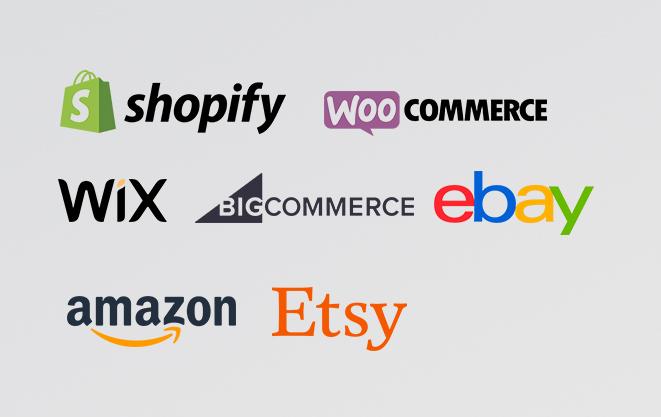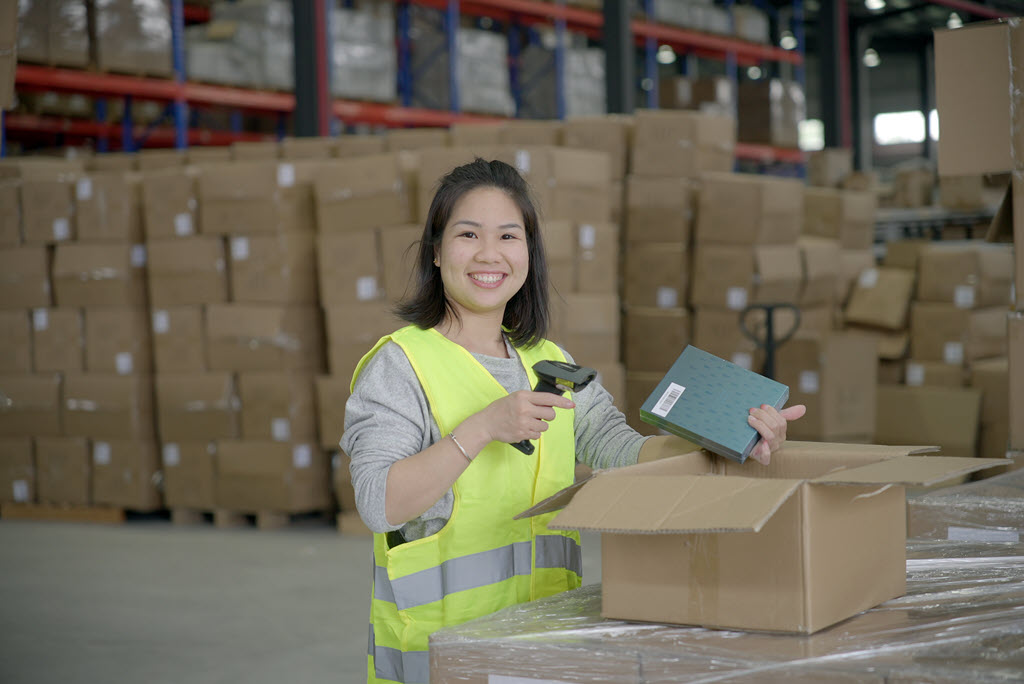When it comes to storing inventory, you get to choose from two options: either manage it in your own warehouse or rely on fulfillment centers. Where the former demands you to put in effort managing everything on your own, the latter is a more advanced option, owing to which you can streamline your storing, packaging, and shipping processes.
If you’re a business owner seeking to streamline your operations or simply interested in how goods are stored and shipped, we’ve got you covered. Read this article until the end to develop a clear-cut understanding of the basic differences between warehouses and fulfillment centers.

Part 1. What is a Warehouse?
A warehouse can be considered the superhero of storage in the business world. It’s where goods, equipment, and other items reside temporarily. Warehouses play a role in ensuring the flow of goods from their production point to their ultimate destination. They handle tasks such as inventory management, preparing orders for shipping, packaging products, and much more!
The types of warehouses are pretty diverse. There are kinds of warehouses, such as government facilities catering to public requirements, privately owned ones by companies, and public ones managed by logistics experts specializing in 4PL or 3PL services.
Part 2. What is a Fulfillment Center?
A fulfillment center is like a super-efficient warehouse tailor-made for online shopping. It’s where the magic happens when you click “buy” on your favorite e-commerce site. These centers are experts in ensuring your online orders go seamlessly from your screen to your doorstep.

Inside a fulfillment center, products are carefully stored on organized shelves or in bins, ready to be picked and packed by workers. They put together your order, add the shipping label, and send it. Fulfillment centers also handle returns and exchanges, ensuring your online shopping experience is as smooth as possible.
Part 3. How Does Fulfillment Center Work?
Let’s find out how the fulfillment center works:
Tip: If you want to save fulfillment costs, you can rely on 3PL services like NextSmartShip.
Integration with Your Online Store
It all starts with integrating your online store with the fulfillment center. This means your store talks to the fulfillment center’s systems. Think of it like a backstage pass for your e-commerce.

Popular platforms like Shopify, WooCommerce, or Magento make this connection possible. This integration lets the fulfillment center know what your customers are ordering, your inventory levels, and how you like things shipped.
Sending Goods to the Fulfillment Center
Next up, you send your products to the fulfillment center. They’ll find a cozy spot for your stuff in their warehouse. You can send goods in big batches or one by one, depending on your needs. When your goods arrive, the fulfillment center gives them a thorough check, slaps on labels, and scans them. This keeps your inventory up to date.

Real-Time Inventory Management
Imagine having a super-smart inventory manager who works 24/7. That’s what a fulfillment center offers. You can keep tabs on your inventory in real time through their online dashboard or app. Track what’s selling, like hotcakes, when to reorder, and even get alerts for low stock or any inventory hiccups. Plus, the fulfillment center’s data insights help you make smarter decisions.
Pick, Kitting, Pack
When a customer places an order on your online store, the fulfillment center springs into action. First, a picker is assigned to the order. They hunt down the exact items in the warehouse, scan them with their trusty barcode scanner, and pop them into a bin or cart.

Once they’ve got everything, it’s off to the packing station. There, a packer checks the order to make sure it’s spot on, packs it neatly into the right-sized box or envelope, adds any necessary padding or extras, seals the deal, and prints out a shipping label.
Order Processing and Fulfillment
With the order all boxed up and labeled, it’s time to hit the road. The fulfillment center handles the nitty-gritty of processing and fulfilling the order according to your economy shipping preferences and what your customers expect. They team up with different shipping carriers and services to deliver that package to your customer’s doorstep.
The best part? You and your customer can keep an eye on the package’s journey with tracking info and delivery confirmation; if there are any bumps in the road, like delays or hiccups, the fulfillment center steps in to sort them out, taking the stress off your plate.
Part 4. Warehouse vs Fulfillment Center: Difference?
Let’s clear up the warehouse and fulfillment center confusion. These two are like cousins in the storage world, but they have some crucial differences.
Storage vs. Action
A clear difference between a warehouse and a fulfillment center is that a warehouse is like a storage superhero. It’s where goods hang out for the long haul. It doesn’t do much besides keeping stuff safe.
On the other hand, a fulfillment center is all action. It’s the MVP of order fulfillment, handling everything from getting products to processing, packing, and shipping orders. It’s a bustling hub in the supply chain.
Cost and Complexity
Another exclusive difference between warehouse and fulfillment services lies in the cost and complexity. Warehouse costs are budget-friendly for long-term storage, but watch out for extra handling and transportation fees. Fulfillment centers may cost more for storage, but they often save you money on shipping and handling, thanks to their efficient processes and partnerships.
Independence vs. Integration
Warehouses are loners; they do their thing without much interaction with the supply chain. Fulfillment centers, though, are social butterflies. They’re all about teamwork, working with suppliers, manufacturers, and customers to get your orders on the move.
Tech and Tools
Warehouses keep it simple with basic equipment like forklifts and crates. Fulfillment centers, on the other hand, are high-tech. They’ve got barcode scanners, inventory management systems, and real-time data at their fingertips. They’re the tech whizzes of storage.
So, in a nutshell, warehouses and fulfillment centers might store stuff, but they’re as different as night and day in what they do and how they do it. Depending on your business needs, you might go for one, the other, or even a combo of both. It’s all about finding the right fit for your storage needs!
Part 5. Why Fulfillment Center is Important in Order Fulfillment?
A fulfillment center plays a crucial role in order fulfillment, and here’s why it’s so important. Suppose you’ve got a bunch of orders pouring in, and you want to get your products to your customers faster, cheaper, and without a hitch. That’s where a fulfillment center becomes highly crucial!
Outsourcing Expertise
You can hand over the entire order fulfillment process to a third-party logistics provider (3PL) who knows their stuff. They’ve got the infrastructure, tech, and skills to make it all happen like clockwork. By doing this, you save time, money, and the headaches of running your warehouse or hiring your crew.
Tip: If you want to save fulfillment costs, you can rely on 3PL services like NextSmartShip.
A Strategic Network
These fulfillment centers have warehouses strategically scattered near major transportation hubs and hot markets. This means your products can cozy up closer to your customers. Shorter shipping distances and quicker delivery options like same-day or next-day have become a reality, making your customers super happy.
Real-Time Inventory Control
Managing your inventory is effortless with the fulfillment center’s online dashboard or app. You get to keep an eye on your stock levels, know what’s selling like hotcakes, and stay updated on order status.
Plus, you can set up nifty alerts for low stock or when something’s running out. The fulfillment center even throws in data-driven insights to make your inventory game even stronger.
By going through these points, you can understand why fulfillment center plays a crucial role in order fulfillment to understand warehouse and fulfillment better!
Bonus. Partner with the Best Warehouse Fulfillment Center
After going through the above-detailed information, you must seek the best warehouse fulfillment center to rely on. If that’s the case, we have got you covered with our best pick, i.e., NextSmartShip! With the aim to support small businesses and direct-to-consumer (DTC) brands, this amazing platform is doing wonders.

Get Custom Solutions
Some of its services include eCommerce fulfillment, Amazon fulfillment, crowdfunding fulfillment, subscription fulfillment, and more. You can also obtain customized packaging, shipping, inventory management, real-time order tracking, and more such services.
Have questions or need assistance? Their dedicated customer service team is there 24/7. They’re not just about business; they share financial wisdom and tips on their blog and social media channels, too.
Wrapping It Up!
Understanding your needs is the key when deciding between a warehouse and a fulfillment center. Where warehouses are great for long-term storage, fulfillment centers offer a comprehensive solution for streamlined order processing. Hope you found this info helpful; stay tuned for more informative guides!
Moreover, if you are looking for the best fulfillment center to partner with, check out NSS! Visit their website to get a quote tailored to your needs.

